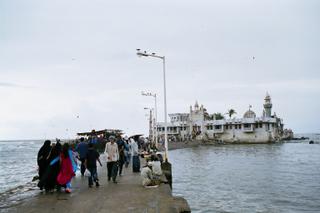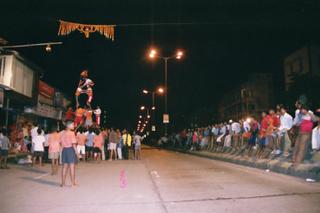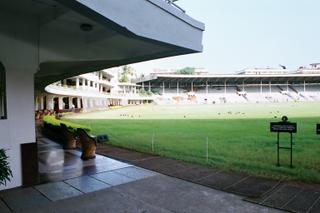The Bombay of Dreams
Mumbai, or Bombay as it was formermly known, will hardly get the attention it deserves in the following few paragraphs, but it is a start. A city that never sleeps, a restless giant of +17m people, a roaring monster that devours anything on its way that fails to tap into the beat fast enough. For example, imagine what traffic is like – the sounds, fumes, the shere agression. No-one is spared. Being used to commuting in the heart of London with its below (European) par transport infrastructure, Mumbai comes across as that amp that goes to eleven. From the memory lane: commuting by train from downtown Colaba to the Bandra suburb during the afternoon rush hour meant sharing a 10sqm compartment with no less than 80 fellow commuters; being the only white person in the carriage meant a lot of attention too, not to mention trying to subdue a teenage itch for panic attacks. The only way to exit was to literally ram one’s way through towards the exit (a few excruciating meters) before being tossed off to the moving platform with the cheerful aid of those left behind (a choice between a kick in the rump or missing the station).
That amp goes to eleven in other ways too. Business, religion, nightlife – survival. It all comes to life in huge volumes and with stunning energy. It is no wonder Goan backpackers are often too happy to leave only after a few days of nosing around. To be able to process this madness more gently, it is well worth getting introduced to the city by locals. (We have mainly Ryan and Gurveer to thank for this, see Lunch at the Hilton below.) In the end, we left with the impression that Mumbai compares very well to its counterparts in the West – should there be any.
Some of the things a Mumbai virgin should not miss...
An introduction to religious worship: Mahalakshmi temple and the neighbouring Haji Ali mosque. On the way to the temple, pick your favourite choice of flowers, coconuts and fabrics in a set of colourful stalls to sacrifice to the goddesses in the temple. Mind you, while some are returned by the priests sorting out the gifts, for example coconuts and valuables are not. Perhaps just best to watch the whole show on the TV screen outside the inner sanctum. It takes more courage to reach the mosque down the road. Pilgrims must literally walk on water (and fend off scores of beggars on the way), perhaps in a test of faith. Once there, mingle with the cops, it just feels safer that way, the sight of westerners with cameras may not be as welcome as with the hindus next door. [below the passage to Haji Ali]

An introduction to shopping; Fort bazaars. We never got further than Crawford Market, but if you thought Brick Lane Market in London was a walk on the wildside, then think again – steer clear of the chicken stalls! The Fort area itself hosts a myriad of shops offering anything from cheap books and pirate DVDs to tailors and textiles. No McDo, KFC, Greenpeace volunteers or parking wardens to spoil the experience. Ha!
An introduction to partying; Govinda Festival. Nevermind the occasion, most religious festivals take place on wholly different proportions than in boring Old Europe (with the exception of the crowds Papa Razzi pulls these days); or the events taking place during the actual celebrations (with hundreds of thousands of hindu gods alone, diverse traditions are the norm). We stumbled over a tipsy crowd of young lads having a go at the Govinda celebrations one day early. Similar to a distant Spanish tradition, this particular fiesta entailed creating a human tower to smash a jar of buttermilk dangling somewhere mid-air. Of course, the lightest rascal is sent to climb up top. He tends to brave his way up without the customary performance enhancers (read: cheap brandy), but is reassured of his safety by wearing a biking helmet. His safe return is celebrated by fire crackers, dancing, and the odd gulp of, ehm, buttermilk I am sure.

An introduction to most things hip; the Colaba. I would be surprised if downtown Mumbai leaves any of its visitors bored. From delicious eateries to cinemas, sports clubs, lush hotels, shops and nightlife, the area referred to as the Colaba caters for most of Mumbai’s immediate scene. Don’t get me wrong here, this stuff comes with a well roasted local flair, and the copycat whiff of Banglaore where it is considered cool to hang out at the mall with the Simpsons and Bundies is, thankfully, non-existent. Of course, there are other parts of town with specific scenes too such as Bandra and Juhu. But Colaba offers arguably the best spots to chill out from the hustle and bustle of the city and, indeed, at times, from the rest of the country. To mention but a few of the pearls – the grub and views at the rooftop Arab restaurant Koyla, the numerous cafès specialising in chocolate-covered sins such as Mocha, the chilled beer at the rooftop bar of the Intercontinental Hotel (again, the views, and they have a pool too!), lunch at the Cricket Club of India, and the European toilets and warmwater showers at the YWCA. Bless them all, for they felt like an oasis for those of us lucky enough to afford to escape the demons for a little while. And damn us all for enjoying such snobbery for a weekend or two! [below a view from the Cricket Club of India]

<< Home